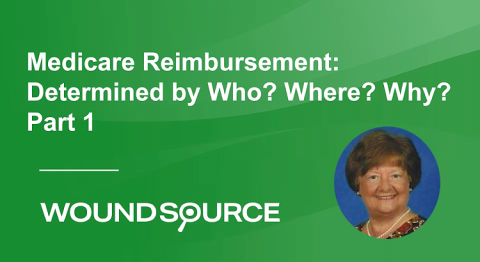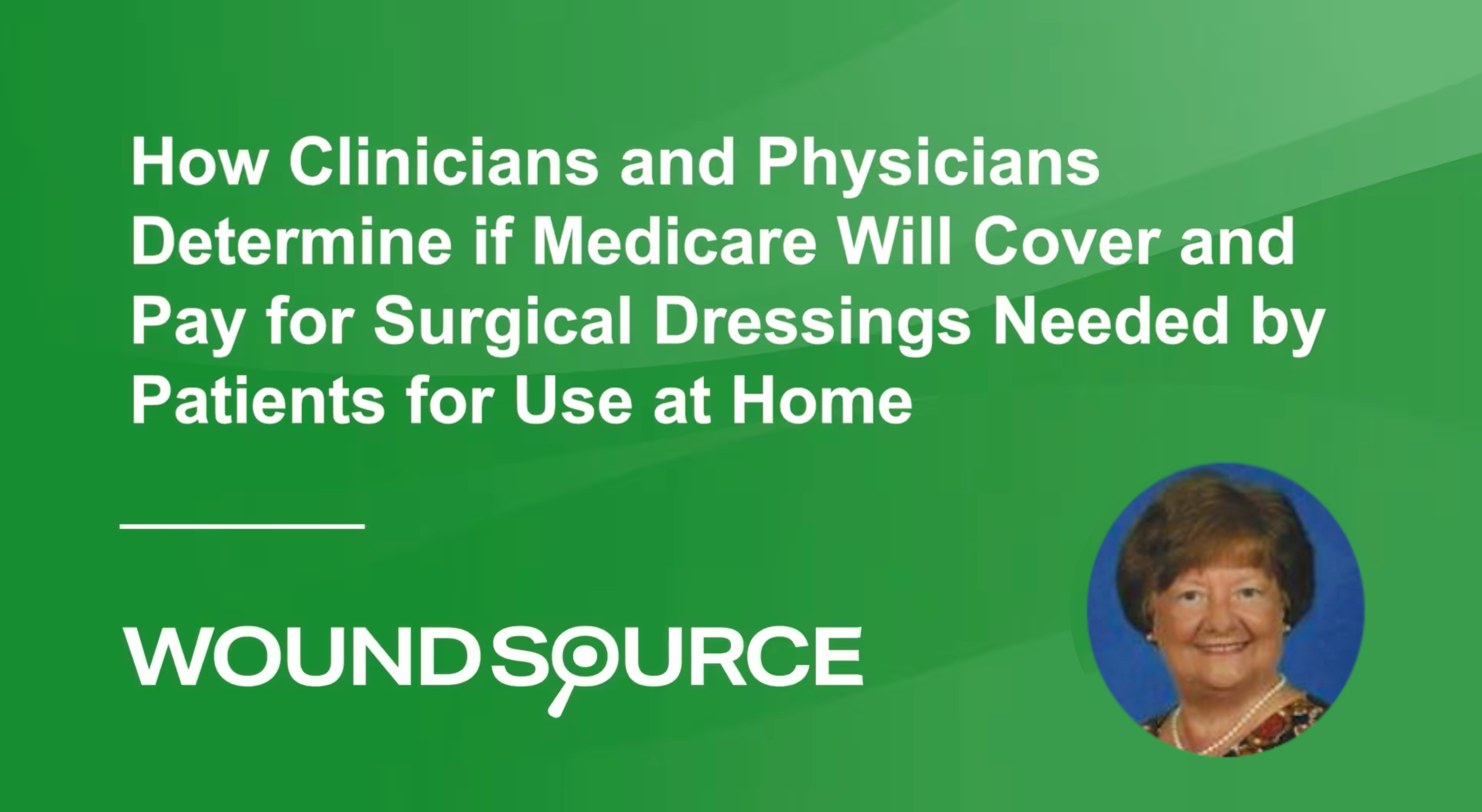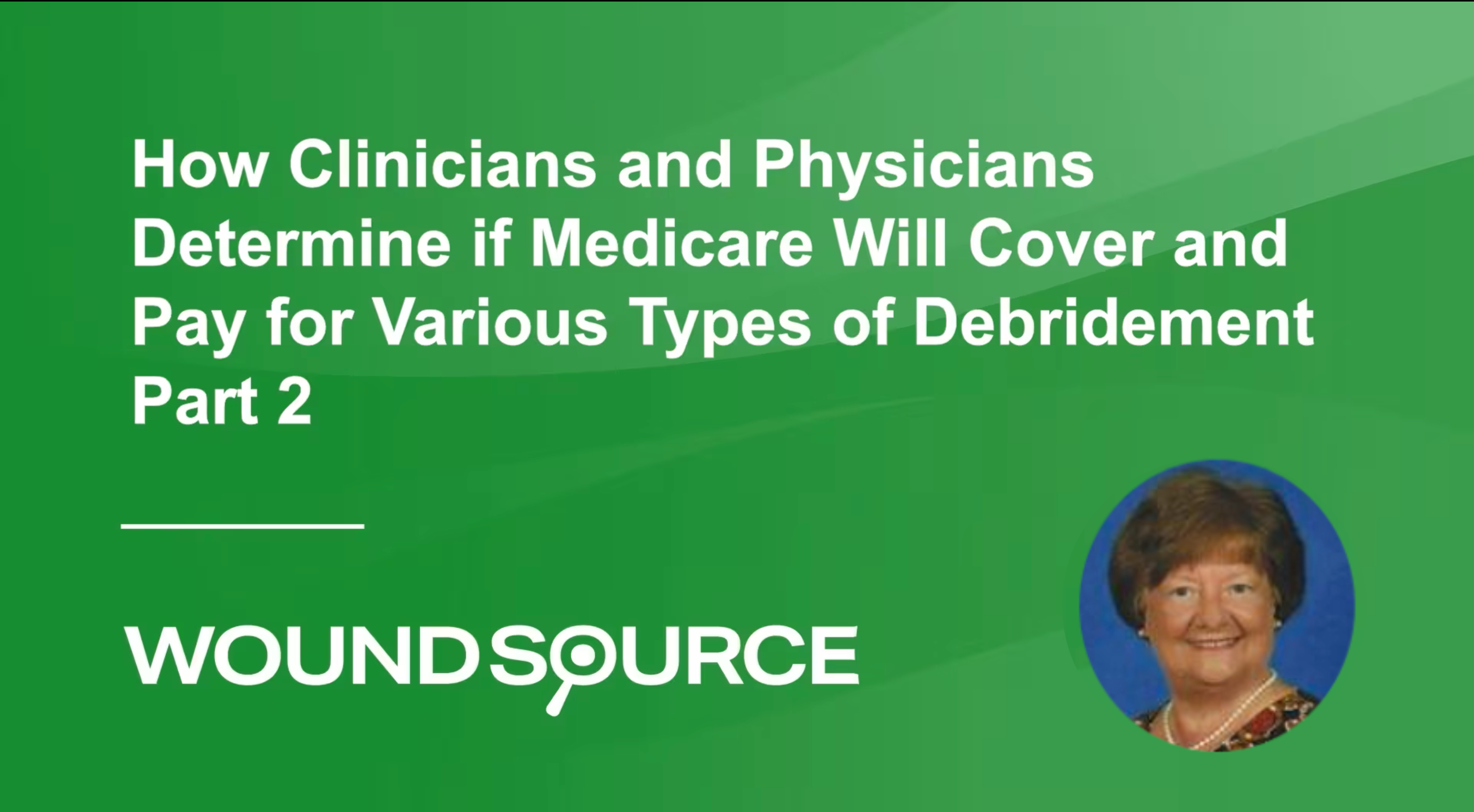Part 1: Clinicians’ and Physicians’ Vital Roles in Receiving Appropriate Medicare Reimbursement
September 22, 2023
Medicare Reimbursement: Determined by Who? Where? Why? Part 1 from HMP on Vimeo.
Transcript
Welcome to the first video in this 3-part series entitled Clinicians' and Physicians' Vital Roles in Receiving Appropriate Medicare Reimbursement. I selected that title because most wound/ulcer management professionals mistakenly believe that the Centers for Medicare & Medicaid Services and the Medicare Administrative Contractor that processes their claims are solely responsible for determining their reimbursement. That belief is not entirely true. If a service procedure or product is included in a Medicare covered benefit and is assigned a code, clinicians and physicians should learn and implement coverage and coding guidelines. Their medical decision-making, documentation and coding of each patient encounter determines their reimbursement. If their documentation and coding align with the coverage and coding guidelines, they will usually be paid correctly, but if their documentation and coding do not align with the guidelines, they will usually be paid incorrectly or not at all. Therefore, when all is said and done, clinicians and physicians play a vital role in their Medicare reimbursement.
My name is Kathleen Schaum and I am the President of Kathleen D. Schaum & Associates, which is a reimbursement strategy and education consulting company. I provide these consulting services to physicians and other qualified healthcare professionals, to hospital-owned outpatient wound/ulcer management provider-based departments, and to manufacturers and distributors of wound/ulcer management products. Because I love my work and strive to educate wound and ulcer management stakeholders how to be paid correctly and fairly for the services, products, and procedures they provide to patients, I am honored that WoundSource invited me to share reimbursement information with you.
If you wish to contact me, feel free to call me on my mobile phone or to email me. My phone number and email address are shown on this slide.
As I just mentioned, this video series consists of 3 parts and will meet 3 objectives. In part 1, we will learn that Medicare reimbursement is first determined by the answers to 4 questions. Who? Where? What? And why? In part 2, we will discuss how clinicians and physicians determine if Medicare will cover and pay for various types of debridement. And in part 3, we will discuss how clinicians and physicians determine if Medicare will cover and pay for surgical dressings needed by their patients for use at home.
Before we begin part 1, let us review the disclaimer for today's reimbursement education. Information on coding coverage and payment systems is provided as a courtesy, but it does not constitute a guarantee or warranty that payment will be provided. Each attendee is advised to obtain from the correct payer current coding, payment system, and coverage policies and regulations that pertain to the specific work they perform.
Now, let us begin part 1 of this series. Medicare reimbursement is first determined by answering four questions. Who? Where? What? And why? Many times per week, I receive calls and emails asking me the same question, "Does Medicare pay for a particular," and they'll name a service or procedure or a product, "and how much do they pay?" The person asking the question is always surprised when I respond by saying, "I have no idea." First, you'll need to describe the scenario to me. Who will perform the work? Where will the encounter take place? What will be performed and provided, and why will the particular service, procedure, or product be performed or provided? I always explain to the caller that Medicare payment may change significantly depending on the answers to those 4 questions.
First, let us consider why it is important to identify who will perform the work. The state practice acts and the Medicare legislation and regulations may vary for each of the wound and ulcer management professionals listed on this slide. If a professional's state scope of practice does not allow her or him to perform a certain procedure, Medicare will not pay that professional, regardless if a procedure is covered, has a code or has a Medicare payment rate.
The coverage, coding, and payment regulations may be different for the various professionals. Therefore, the person who performed the work must include their credentials in their documentation. In addition, if a particular professional wishes to perform certain procedures in a facility, she or he must identify if the facility's bylaws allow that professional with that specialty to perform the work. If the answer is yes, she or he should also verify that the professional was granted privileges to perform the procedure in that facility. For example, some hospitals may not grant surgical procedure privileges to nurse practitioners and physician assistants. In those hospitals, NPs and PAs may not perform procedures such as surgical debridement of subcutaneous tissue, muscle, and bone.
Here is an example to show the importance of identifying and documenting in the medical record who performed the work. This example, we're in a hospital-owned outpatient wound/ulcer management provider-based department, and that acronym is PBD. And in the PBD, a physician assessed a patient's venous ulcer and then asked the wound care nurse to apply a multi-layer compression bandage. The application of the multi-layer compression bandage is in the scope of practice of both professionals. In addition, nothing in the hospital bylaws prevents either professional from performing the procedure. The physician could document the assessment by medical decision-making that she or he performed, as well as the order for the wound care nurse to apply the compression bandage. The wound care nurse should fully document the application of the multi-layer compression bandage that she did. The physician then should report the appropriate level of evaluation and management based on either medical decision-making or time, but the PBD should report the code for the application of the multi-layer compression bandage, which in this case is 29581. Under no circumstances should the physician also report 29581 on her or his claim form, because she or he did not perform the work in the PBD.
Before answering any reimbursement question, we must identify where the patient encounter occurred, because Medicare coverage and payment varies in different places of service. For example, physicians and other qualified healthcare professionals, whose acronym is QHP, often provide wound/ulcer management services in several places of service on the same calendar day. The Medicare physician fee schedule pays physicians and QHPs more for performing work in their offices than in PBDs. These physicians and QHPs should do 2 things. Number 1, document in the medical record where the encounter occurred, and 2, establish a process for providing that information to their coders and billers. Failure to report the correct place of service on claim forms can lead to both underpayments and overpayments.
Here is an example of the importance of documenting the place of service correctly and reporting it correctly on claim forms. On Monday morning, a physician applied cellular and/or tissue-based products for skin wounds in his office. The acronym for cellular and tissue-based products is CTPs. On Monday afternoon, the physician performed CTP applications in the provider-based department. Now, because the physician performed work in different places of service, he should document each place of service in the medical record. In addition, if the physician records his work on a charge sheet, the charge sheet should have a place for the physician to identify where the work was performed. If that information is not shared with the coders and billers, the claim form may incorrectly report that the physician, excuse me, that the physician performed all the work in his office. That will result in an overpayment for the work performed in the provider-based department.
What was performed or provided, and why? The answers to these last 2 important questions are frequently not documented thoroughly. These questions again are, what was performed or provided, and why? First, the physician or QHP should document a patient's specific diagnosis or diagnoses that supports the medical necessity of the work performed. If the physician's diagnosis is not covered by the patient's payer for the work that's performed, the claim will be denied. Now, if a service such as some level of evaluation and management was performed, documentation in the medical record should follow the American Medical Association's medical decision-making or time guidelines.
Now, if the procedure is something like debridement or application of a CTP, the clinical reason why the procedure was performed should be based on clinical practice guidelines, published evidence, the LCDs, the LCAs, and it should be well documented.
In addition, the exact procedure should be fully described, and the documentation should include all the coverage and coding criteria required by your MAC's LCD and LCA. If a product was used or ordered such as a specific surgical dressing or a specific CTP, the physician should document why that specific dressing or CTP was selected, and this is particularly important when a more expensive product was ordered or used instead of a less expensive product that was also available.
By now, you should better understand why you must paint the picture of your exact scenario when you document in the medical record, or even when you call me and ask me a reimbursement question. This slide shows you 2 really great examples of 2 reimbursement questions that I received recently. Where you see the word no, that is the question that the caller asked that I could not answer because I didn't have enough information.
Where you see the word yes, that is the scenario that the caller then reported to me that allowed me to answer the question correctly.
So, the first question was, "How much will Medicare pay a physician when a nurse practitioner performs debridement?" I had no idea where this was or anything, so I said, "Could you please explain this a little more to me?" And the caller said, "I'm a nurse practitioner and I work in a PBD. Can the PBD medical director bill Medicare for my work, such as surgical debridement of subcutaneous tissue, 'incident to' his work?" Oh, that made the world's difference of how specific we could be with the answer to this. In case you're wondering, the answer would be that the medical director could not bill for this in a PBD because it is not his office, and the nurse practitioner was not working incident to that medical director in the PBD. So they would be billing under the nurse practitioner's NPI number, and then that would be the payment they would get paid as a nurse practitioner.
So, you could see that that answer could have been very different if I just answered the first question.
A second one that came to me was, "How much does Medicare pay nurses who debride wounds?" I was scratching my head saying, "Could you tell me more about that?" And the caller said, "I'm a nurse who just received my WOCN certification. I work in a PBD. May I now bill Medicare for my work such as selective debridement?" Oh, that makes a big difference, right? So I was able to say, "First and foremost, WOCNs, no matter whether we're certified or not, we cannot bill Medicare for our services. We cannot get an NPI number. But when you're working in a PBD or some other facility, the facility would be billing for the work done in the facility, which would include the WOCN's work, but there would not be a direct bill to Medicare from the WOCN." So, I want you to see how specific the scenario ought to be in order us to answer the questions, and that's how specifically you have to document when you are doing the work.
This slide lists just a few of the many LCDs and LCAs that the MACs released to provide coverage, documentation, and coding guidelines. You can find these and many more at the website provided on the top of the slide. Simply search for the LCD number that begins with the letter L and the article number that begins with the letter A. You should also search the entire database for all LCDs and LCAs that your MAC released pertinent to any work that you perform, then you should carefully read the LCDs and LCAs. Once you read these guidance documents, you will better understand why I tell you that clinicians and physicians play a vital role in receiving Medicare reimbursement. CMS writes the regulations, your MAC writes the coding and coverage guidelines, but clinicians and physicians write the orders, provide the documentation, and submit the codes, which must align with the coverage, coding, and payment guidelines.
Thank you for allowing me to share reimbursement information with you. I hope you will listen to the other 2 parts of this series. In the meantime, if I can be of assistance to provide reimbursement consultation or education to individuals or groups or health systems, or at local or regional national symposiums, or to manufacturers' executives or sales representatives, feel free to contact me at the number or email that was listed on the slide at the beginning of the presentation. Good luck in doing your part to gain Medicare coverage and payment. Don't underestimate your vital role in this process.
About the Speaker
As the founder and president of her consulting company Kathleen D. Schaum & Associates, Inc., Kathleen Schaum shares her 50+ years of knowledge and experience with wound/ulcer management stakeholders. For the past 24 years, Kathleen has educated and consulted with wound/ulcer management providers and manufacturers. In addition, Ms. Schaum has guided manufacturers’ reimbursement strategies for nearly 500 wound/ulcer management products and procedures and has provided reimbursement education to 6,000+ executives and sales representatives. Ms. Schaum consults with numerous new and established hospital owned outpatient wound/ulcer management departments and wound/ulcer management professionals regarding the “business side of wound/ulcer management.” Her reimbursement teleconsultation services, Charge Description Master reviews, and coding/billing guidance provides a “lifeline” for many wound/ulcer management professionals and revenue cycle teams.
Ms. Schaum continuously monitors reimbursement legislation and regulations and attends many reimbursement meetings and seminars to maintain her own knowledge regarding this ever-changing topic. Then she willingly shares that knowledge with wound/ulcer management stakeholders at national and regional symposiums and via her monthly reimbursement columns: Payment Strategies in Advances in Skin & Wound Care and Business Briefs in Today’s Wound Clinic, as well as her new column, entitled Consultation Corner, which appears quarterly in Today’s Wound Clinic. Based on her published articles, Kathleen was recently recognized as a world expert of reimbursement health insurance – she is in the top 0.089% and ranks number 26 out of 30,441 published worldwide authors.
About the Speaker
As the founder and president of her consulting company Kathleen D. Schaum & Associates, Inc., Kathleen Schaum shares her 50+ years of knowledge and experience with wound/ulcer management stakeholders. For the past 24 years, Kathleen has educated and consulted with wound/ulcer management providers and manufacturers. In addition, Ms. Schaum has guided manufacturers’ reimbursement strategies for nearly 500 wound/ulcer management products and procedures and has provided reimbursement education to 6,000+ executives and sales representatives. Ms. Schaum consults with numerous new and established hospital owned outpatient wound/ulcer management departments and wound/ulcer management professionals regarding the “business side of wound/ulcer management.” Her reimbursement teleconsultation services, Charge Description Master reviews, and coding/billing guidance provides a “lifeline” for many wound/ulcer management professionals and revenue cycle teams.
Ms. Schaum continuously monitors reimbursement legislation and regulations and attends many reimbursement meetings and seminars to maintain her own knowledge regarding this ever-changing topic. Then she willingly shares that knowledge with wound/ulcer management stakeholders at national and regional symposiums and via her monthly reimbursement columns: Payment Strategies in Advances in Skin & Wound Care and Business Briefs in Today’s Wound Clinic, as well as her new column, entitled Consultation Corner, which appears quarterly in Today’s Wound Clinic. Based on her published articles, Kathleen was recently recognized as a world expert of reimbursement health insurance – she is in the top 0.089% and ranks number 26 out of 30,441 published worldwide authors.
The views and opinions expressed in this blog are solely those of the author, and do not represent the views of WoundSource, HMP Global, its affiliates, or subsidiary companies.











Follow WoundSource
Tweets by WoundSource